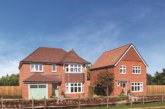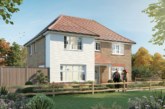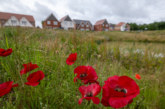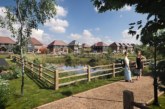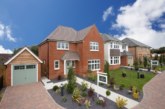FTSE-250 housebuilder Redrow reveals that Britain’s future housing preferences include private driveways, low density design and semi-detached and detached homes. These preferences are not aligned with parts of the government’s proposed changes to housing design which are outlined in the National Model Design Code (NMDC).
To underpin its commitment to creating a better way to live, particularly in a post-pandemic world, Redrow is closely monitoring consumer trends around what people want from their home and community, in order to respond accordingly. Two extensive independent online surveys which separately polled over 2,000 British adults and more than 500 local councillors in England and Wales were conducted via YouGov to provide insight into consumer home design and architecture preferences, neighbourly relations, and aspirations for their local areas.
Responses from just under 500 councillors from across England alone reveals that more than half (51%) of councillors are not sufficiently familiar with the NMDC to give a view on how it will be received by their constituents, despite the consultation period ending on Saturday 27th March. The findings are surprising, given that 3 in 5 respondents of the survey either currently sit on, or have sat on, a planning committee. In addition, 75% of the sample have either held a Cabinet position, a portfolio or have been Chair/Vice Chair of a Council committee in the last three years.
Furthermore, of the 2,000 consumers polled, when asked to choose a new build home that they would aspire to live in most, only 3% and 4% of respondents stated they would choose to live within a terraced home or townhouse respectively.
The findings are significant, as whilst the research shows that local councillors both understand and are aligned with Britain’s preferences for post-COVID housing, future properties may not reflect the nation’s needs due to conflicting guidelines in the proposed NMDC. What’s more, the survey also reveals that of those councillors who feel sufficiently familiar with the NMDC, just 13% believe that the guidelines would be well received locally by their constituents.
Architecture and housing design
The research concludes that spacious living arrangements that offer functionality to adapt, spread out and create dedicated spaces for working, play and living are now at the forefront of Brits’ minds. When asked to choose a new build home that they would aspire to live in most, the overwhelming majority of consumers (77%) aspire to live in a two-storey detached home, with an equal split between a preference for a more contemporary and period style.
Detached homes came out top for councillors who were asked about the housing style most likely to have a positive impact upon quality of life, with the majority of Conservative (78%) and Labour (63%) councillors agreeing. Only a small minority are supportive of the encouragement in the NMDC for townhouses with three storeys (15%), whilst only 14% supported guidance for unallocated parking in car barns. Crucially, more than half of all councillors (52%) confirmed there is “high demand” for family homes in their area.
When asked what the most pressing design need is for those they represent, private driveways came out top, with 70% of councillors stating that they would like to see houses with their own driveways to the front or the side of the house built in their local area. Furthermore, 77% cited competition for parking as one of the top five issues raised with them by their constituents.
Kevin Parker, Group Master Planning Director at Redrow, comments: “With the majority of the nation spending more time in their homes than ever before over the last 12 months, our personal living situations and housing needs have been put under the microscope. It is crucial that housebuilders and policy makers listen closely to how consumer preferences have changed during the pandemic to create the most suitable homes on an informed basis.
“However, our findings suggest there is currently a disconnect between some of the guidelines proposed by the NMDC and the views of local councillors and their residents. We would urge the government to consult widely with these groups on the important issue of housing design, which shapes our future communities and, ultimately, impacts individual well-being. Based on our consumer findings we now call on the government to build more flexibility into the indicative guidance in the National Model Design Code, to include encouragement toward a broader range of house types to reflect different needs in different communities.”
Local surroundings and amenities
A desire to be near green, open spaces, also rings true within the research, with 95% of respondents stating that they would find being near to open spaces beneficial in any future home move. Today, more people are keen to get into exercise mode in their own home, with 61% of respondents stating that it would be beneficial to have enough space in their home to exercise or create a home gym.
Attractive streets are important to consumers too, with 88% stating that a street comprising homes of the same style but with their own individual character would be their preference over homes that were the same build as every other home on the street. Encouragement of tree-lined streets is also broadly supported by councillors, with 84% stating this element of the NMDC was most appealing to them and the residents they represent. Meanwhile, creating neighbourhoods with names and distinctive identities was also voted as ‘appealing’ by the majority of councillors (71%).
Neighbourly relations
When it comes to the subject of neighbourly relations, 70% of respondents believe it is important to personally know their neighbours. Even respondents in London placed great importance on now knowing those they live close to, with 67% of Londoners stating it was important to know their neighbours personally. Those in the South East placed the most importance on knowing their neighbours, with over three quarters (76%) stating it was important to personally know their neighbours.
Of those who have neighbours, half (50%) are now interacting with their neighbours in a positive manner on a weekly basis. When analysing daily interactions, respondents in Wales stood out as having the highest proportion of positive engagements with neighbours at 27%, compared to the English average of 16%. The next highest were people in Scotland and the North East of England at 19%.
Kevin Parker, Group Master Planning Director at Redrow, continues: “These consumer findings support our current thinking around placemaking. We build our communities so they provide residents with thoughtful, natural communal outdoor spaces and amenities which are ideal for creating those ‘chance’ interactions between neighbours which help relationships flourish and build social cohesion. ‘Nature for people’ is one of eight placemaking principles integral to every one of our developments and we strive to provide a legacy of green spaces and natural habitats for wildlife and people alike.”


